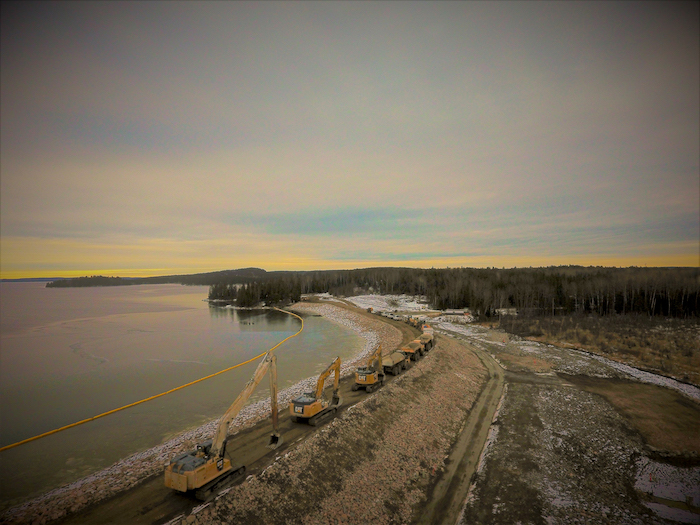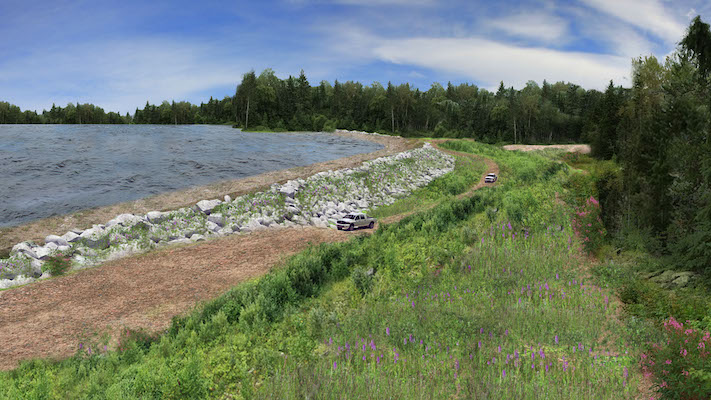
2023 #CCEAwards Showcase: Caribou Falls Block Dam 2 Reconstruction
November 9, 2023
By CCE
“A good example of engineers’ ability to innovate and adapt to site conditions.” – Jury
Category: Water Resources
Award of Excellence Winner: KGS Group
Ontario Power Generation (OPG) retained KGS Group to design and supervise the reconstruction of the Caribou Falls Generating Station Block Dam 2, which had sustained unexpected slope movements. It is one of four earth dams that contain the reservoir (Umfreville Lake) for the station.
Advanced techniques, innovative materials and sound engineering judgment were applied to construct a new earthfill dam. The design integrated constructability, risk mitigation and time-saving strategies at the planning level. The dam and its generation capacity were restored within budget and schedule, while preserving the pristine natural surroundings.
Optimizing the solution
Situated in the rugged Canadian Shield in Northwestern Ontario, Block Dam 2 contains the reservoir for OPG’s Caribou Falls Generating Station. Built in 1958, the station and dams were operating reliably when, after 60 years of service, significant movement suddenly occurred on the upstream slope. For dam safety purposes, OPG partly lowered the reservoir level, reducing power generation capacity.
OPG retained KGS for investigations, design (conceptual through to detailed), contract administration and dam performance monitoring for the project’s construction and post-construction phases.
KGS used several investigation techniques to characterize the site, including a seismic refraction geophysical survey and seismic cone penetrometer testing (SCPTu). The latter allowed the firm to quickly obtain data from probes across the site, providing a dense spatial array of foundation soil information in a relatively short time frame.
A focused analysis of this data allowed the design team to optimize the new dam’s geometry to resist potential earthquake-induced instability, rather than incorporate traditional, expensive ground improvement methods.
The solution involved building a replacement cement-bentonite (CB) wall core dam on the downstream side of the original dam, while maintaining it as the construction cofferdam. Once the new embankment was rebuilt close to full height, the core trench was excavated while a slurry of water, cement and bentonite was continuously added, to prevent the sand trench walls from collapsing.
Once cured, the slurry-filled trench became the new water-retaining core of the dam. The relative ease of the granular fill embankment construction followed by slurry trenching, which could be undertaken in almost any weather conditions, minimized the project’s vulnerability to seasonal restrictions and delays. Also, the CB wall’s slender footprint allowed for the new dam to be built immediately against the downstream slope of the old dam, to fit within the confined project boundary and minimize the amount of material needed.
To ensure the slurry trenching machines wouldn’t get stuck in the deepest, densest section of the foundation, the contractor equipped long-reach excavators with three custom interchangeable implements that could tear through dense gravel and pluck out boulders.
Hazard potential
When Block Dam 2 sustained slope movements without warning, part of the crest dropped 1.5 m, exposing internal earthfill materials and potentially compromising the integrity of the core. Maintaining the dam was crucial, as it retains Umfreville Lake.
Ontario’s ministry of natural resources and forestry rates Block Dam 2 ‘extreme’ under its Hazard Potential Classification System. This classification, along with the unexplainable movement, compelled OPG to expedite the complete replacement of the dam.
The foundation across the entire site was dominated by a unique, altered type of Lake Agassiz clay. An inadequate understanding of the strength and mechanical behaviour of this material has historically been the root cause of instabilities for other water-retaining structures.
To address this issue, KGS implemented a multi-pronged approach for stability and seepage control measures, including construction of the CB wall core, shear key, chimney drain, filter blanket and a toe berm.
During construction, highly irregular bedrock with a fracture zone was encountered that could cause significant leakage. The team reacted immediately, optimizing the dam alignment and narrowing the core to avoid the irregular surfaces. A bedrock grouting program was also designed to make the fracture zone watertight.
Every effort was made to prevent an uncontrolled release of water from Umfreville Lake. Such an event would have both safety impacts and catastrophic environmental consequences.
To manage the risks associated with the project, OPG also held regular review sessions with its dam safety expert panel of internationally recognized engineers. Input from this panel was directly incorporated at key stages of the project, from preliminary design through construction.
The replacement dam was designed to meet modern standards, constructed under full-time supervision by the designer and augmented with state-of-the-art instrumentation and built-in telemetry to support OPG’s dam safety monitoring and surveillance program.
Benefiting communities
The region surrounding Caribou Falls is pristine, vast and beautiful, with a rich history encompassing sacred sites of great importance to local First Nations. The project site is located within Treaty 3 and the region is traditionally used by the Wabaseemoong Independent Nation (WIN) of the Ojibway People, whose community of Whitedog is located 14 km from Caribou Falls.
Many rivers and lakes in the area are host to OPG’s northwest hydroelectric generation stations. OPG’s vision was to protect the fragile environment, address the dam deficiency and benefit local communities.
The project provided employment and skilled trades development for community members, along with a field trip for local First Nations’ high school students to safely experience an active construction site and inspire careers in engineering.
The majority of the rockfill and aggregate products for the construction of the dam were purchased from the local quarry, which is owned by the WIN community. Additionally, while on-site, the team helped the community open a new quarry for commercial development.
The project’s environmental and ecological sensitivities required support from biologists to ensure construction activities were kept safe distances away from a nearby wolf den and eagle nest, as well as to live-salvage fish before in-water excavation works.
First, the contractor deployed a turbidity curtain in the lake to contain the silt-laden water within the confined construction area. Then, the biologists captured and released the fish that were trapped on the construction side of the curtain.
Goals accomplished
The project was completed a month ahead of schedule, allowing OPG to proceed with raising the reservoir back to normal operating levels, restoring the generation station’s power production capacity. The team accomplished the client’s primary goal, restoring Block Dam 2 to modern safety standards on an urgent basis and mitigating the risks associated with the unexpected movement, but also benefited the local community and preserved the natural surroundings.
Caribou Falls Block Dam 2 Reconstruction, Caribou Falls, Ont.
Award-winning firm (prime consultant): KGS Group, Winnipeg, Man. (Dami Adedapo, P.Eng.; Jon Friesen, P.Eng.; David Kurz, P.Eng.; Kelly Fordyce, P.Eng.; Jacqueline MacLennan, P.Eng.; Colin Mohr, P.Eng.; Moises Alfaro).
Owner: Ontario Power Generation (OPG).
Other key players: Kiewit (contractor).

